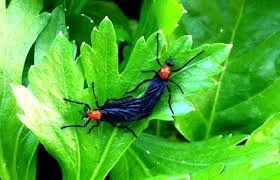by Eric Gibson
People have mixed emotions when it comes to how they feel about Lovebugs. Is it fascination or is it annoyance? Is it envy? Hopefully it’s not envy (you may need to seek a marriage counselor). Maybe it’s a little bit of fascination and annoyance combined! The fascination: how do they fly straight doing…that thing they do? The annoyance: pulling off the highway every 10 miles to scrub the bug splat off your windshield. Read on to curb your fascination with these critters which, in turn, will hopefully limit your annoyance with their behavior.
The Lovebug
Lovebugs are fly-like bugs that are slender, black with a red thorax, and closely related to mosquitoes. Currently, there are two known species of Lovebugs in the United States: native and invasive. There are two Lovebug outbreaks a year: once in the spring (April-May) and once in the fall (August-September).
Annoyance
Although extremely annoying to motorists, Lovebugs are harmless. They don’t feed on human blood or bite and sting; they feed on the nectar from certain blooming plants. Unlike the mosquito, these groovy creatures are all about peace and love, baby!
Love
Like every creature on the planet, Lovebugs are designed to mate and reproduce. In the case of the Lovebug, mating is the ONLY activity that they will partake in before they die. In nature, Lovebugs typically live 3-4 days. Just enough time to…you know (maybe a few times?).
The mating dance starts with the males flying and swarming above the grounded females. Once the female emerges from the vegetation, males immediately swoop down and grasp a female. Much like humans, the males are the ones that are on the prowl. They are in search of the larger females, who have better bods as well as better odds of reproducing. Sometimes, males will interrupt mating and attempt to snatch a desirable female away from another male. Up to ten males have been known to fight over a single female. Talk about a sausage fest!
After finding a match, the mating pair will fly to the ground and rest among the vegetation below. Mating will finish with the male and the female facing in opposite directions. (Much like an old married couple?)
Motorists
Lovebugs seem to congregate near highways where the vegetation on the side of the road is dense. Although Lovebugs don’t cause any bodily harm to humans, motorists are well aware of the damage they do to vehicles. Splattering your windshield and obstructing your view is only the beginning of it. If there is no screen protecting your radiator, these bugs can clog your radiator fins, causing your vehicle to overheat. Also, splattered Lovebugs left on the finish of your hood can pit and stain the paint if not immediately cleaned off. Trust me, I speak from experience when I say: immediately. The hood of my car looks like the pock-marked face of an adolescent with acne scars. It’s best to clean the bugs off your car within hours of reaching your destination. Baby oil is known to aid in bug removal.
Prevention
It has been discovered by professionals that the use of insecticides to limit populations of Lovebugs is ineffective due to the vast number of populations. But if ever there are Lovebugs on your porch, garage or car, the best thing to do is suck them up with a vacuum.
The reduction of Lovebugs in the last few years has been due to the increase of their natural predators. Birds will attack the larvae in the vegetation. Also, fungi is known to affect Lovebug larvae. Invertebrate predators include earwigs, beetle larvae and centipedes.
Well… if these bugs are best regulated by nature, how do we take the proper precautions to avoid Lovebug damage to our vehicles? Great question reader! When Lovebugs are swarming, it’s best to travel at night as they stop flying at dusk. If you have to travel during the day, slow down. This will reduce the amount of splat on your windshield and hood. Also, install a screen over or behind the grill to protect your radiator from getting clogged.
Nozzle Nolen Pest Control supports the lovemaking of the Lovebugs! For any other pest problems, call today for a free inspection!
Eric Gibson is the Director of Marketing for Nozzle Nolen, Inc. of 5400 Broadway, West Palm Beach 33407. For more information about Nozzle Nolen, please visit www.nozzlenolen.com on the web, http://facebook.com/nozzlenolen on Facebook or call (561) 578-4787.

Nozzle Nolen is a member of the U.S. Green Building Council (USGBC). For more information about Nozzle Nolen and its Certified Green Solutions Program, visit www.nozzlenolen.com or call (800) 22-NOLEN.
